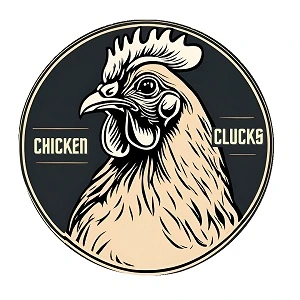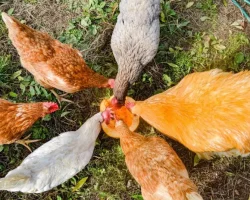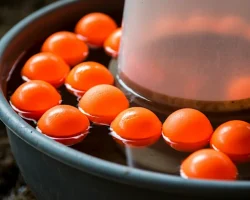As a chicken keeper, you’re probably well aware of two things: feeding your flock is key to healthy chickens, and the importance of using the best chicken feeder.
It would be a pity to provide your hens with high quality chicken feed in a bad chicken feeder! Feeders are essential pieces of chicken equipment.
In my experience, getting the best chicken feeder can be tricky. Investing in the wrong products may lead to constant replacements due to wear and tear problems.
Your chickens must be able to access their feed without any problems so they stay fed and healthy. However, you don’t want to attract vermin to your backyard, nor do you want your chickens to“sit and shit’ on your feed.
Luckily, this article will provide a comprehensive understanding of the different types of chicken feeders available and the factors you should consider to get the best chicken feeder.
The Importance of Choosing the Right Chicken Feeder
Selecting the right chicken feeder is more important than many backyard chicken keepers realize. A well-chosen feeder can make a big difference in your flock’s health, prevent wasted feed, and even deter pests. Here’s why it’s essential to pick the right one:
- Prevents Feed Waste: Chickens are notorious for scratching and spilling feed. A feeder designed to minimize spillage will save you money and keep the feeding area cleaner.
- Keeps Feed Dry and Fresh: Wet or spoiled feed can lead to mold growth, which can be harmful to your chickens. A good feeder protects feed from rain and moisture. Also, it prevents chickens from “sitting and shitting” on top of your feed.
- Reduces Rodents and Pests: Open or poorly designed feeders attract rodents, wild birds, and insects. A secure feeder helps keep unwanted guests out.
- Encourages Healthy Eating: The right feeder ensures your chickens can eat comfortably and get the nutrition they need without competition or bullying.
- Saves Time and Effort: A well-designed feeder reduces the need for constant refilling and cleaning, making your daily chicken care routine easier.
- Supports a Clean Coop: Feed scattered around the coop attracts pests and makes cleaning harder. A feeder that limits spillage keeps the area more sanitary.
By choosing the right chicken feeder, you’re providing your chickens with easy access to fresh and clean feed. The next step is understanding the different types of feeders available and selecting the one that best fits your flock’s needs.
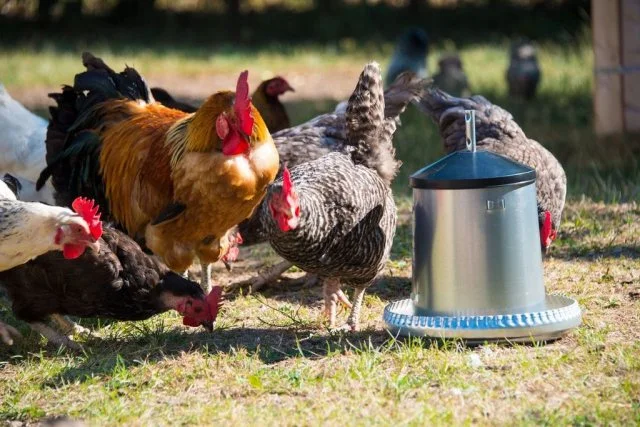
Choosing The Best Chicken Feeder
Don’t just rush out and buy any random chicken feeder. We all have different needs depending on the number of birds we own, the climate, and the type of chickens. Check out these key points to choose the right chicken feeder.
How Many Birds Do You Own?
This is one of the key factors that you must consider before getting a feeder. You don’t want to waste feed nor do you want much competition between the chickens for feed. Let’s explore some key numbers and calculate what your flock needs.
A laying hen normally eats about 4 ounces (114 grams) of feed per day. Let’s calculate with 5 ounces (142 grams) to be on the safe side. Ideally, you want to feed daily to keep the feed fresh, but an extra 1 or 2 days of wiggle room might come in handy. So, for 4 birds your feeder needs to hold: 4 birds x 5 ounces x 3 days = 60 ounces, which is equal to 3,75 pounds (1,7 kg).
So, if you only have 4 to 6 chickens, you will only need a single 5 pound (2,3 kg) feeder. A 10 pound (4,6 kg) feeder can hold enough feed for about 11 chickens. If your flock is larger, you can purchase a larger feeder or multiple small feeders. I prefer multiple smaller feeders if you have enough space, since this helps avoid crowding.
What’s The Climate Like?
The climate is another big factor that many people don’t think about. You’re more likely to experience vermin problems in winter because there’s less feed for rats and mice. An exposed chicken feeder is like an open buffet for rodents. Nobody wants a rodent infestation in their coop. Also, if it rains a lot in your country, it is important to have a chicken feeder with a ‘rain hat’ to keep the feed dry. That’s why it’s essential to get the right feeder and situate it in a safe place for your birds.
What Type Of Chickens Do You Own?
There are many different feeder styles on the market. I advise choosing the best option for the type of chickens you own. For example, if you’re mixing bantams with bigger birds like Rhode Island Reds you must set the feeder at the right height. Also, baby chicks require special chick feeders which are smaller and lower.
How Much Do You Want To Spend?
Your budget will also impact the type of feeder you buy. Unfortunately, it’s a fact that you get what you pay for. A galvanized chicken feeder is more expensive than a plastic chicken feeder but they’re more durable. Automatic feeders are also more costly than basic troughs but they come in handy if you want less work. Sometimes spending more in the beginning can eliminate long-term problems so get the best chicken feeder you can afford.
What Are The Different Types Of Chicken Feeders?
There are many different types of chicken feed stations available. I understand this can be intimidating for new owners but don’t worry! Let’s go through some of the most common feeders now.
Treadle Chicken Feeder: the best rat-proof chicken feeder
This rat-proof chicken feeder is automatic as well, and is one of the most popular styles available today. I highly recommend getting a treadle chicken feeder. It is a great automatic feeder option if you’re worried about rodents stealing your flock’s feed. The brand Grandpa’s Feeders has high-quality ones. The chickens access their feed by stepping on a pedal as they approach it. Mice and rats are too light to press it so it’s an ideal solution. Remember, rodents can contaminate the feed and spread diseases too. Another benefit is they reduce work for owners because they automate the feeding process. Just be careful not to waste feed!
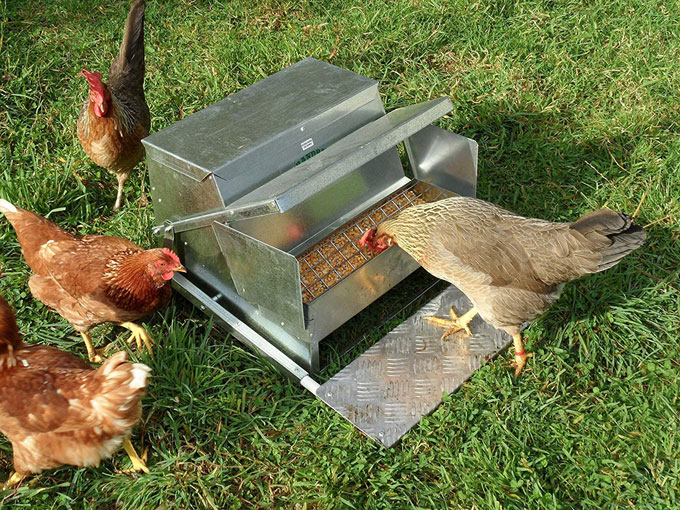
Automatic Chicken Feeder
Automatic chicken feeders are extremely convenient for owners because they reduce your involvement. Most people will immediately think of treadle feeders. However, you can get other simpler versions that automatically release more feed as the chickens eat. These can be very useful but I strongly advise careful use. Avoid overfilling your feeder because this can be problematic. First, your chickens might eat too much feed and suffer health problems. Another issue is that you might waste feed if it sits too long and turns moldy. Finally, don’t neglect to check your chickens every day to make sure that all is well!

Hanging Chicken Feeder
Hanging chicken feeders are also very popular because they drastically reduce feed waste. They’re relatively affordable and very convenient for owners. The only potential issue is that you need somewhere to hang it from. Most experienced hobbyists will agree that chickens aren’t the cleanest birds in the world. They’ll stand and even poop in any ground-level feeders. Hanging feeders are more hygienic and lower cleaning time for keepers. Don’t hang it too high for the smallest bird to reach!
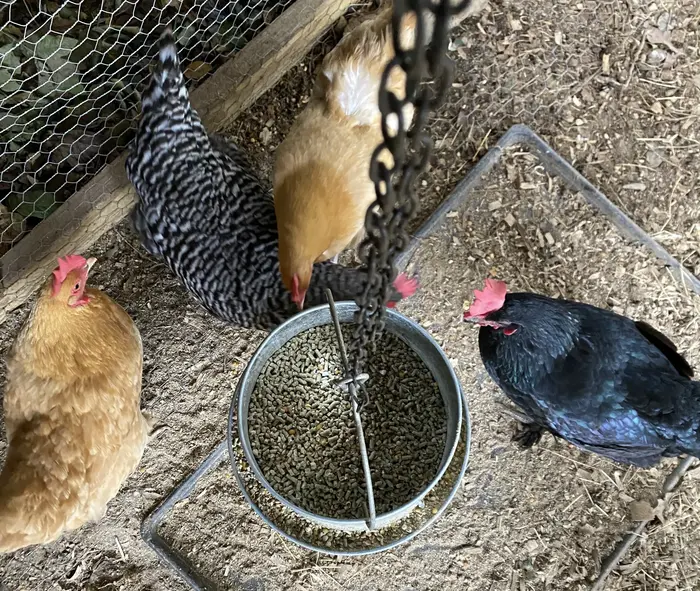
Standing Chicken Feeder
Standing chicken feeders, or ground-level chicken feeders, are a popular choice for backyard flocks, if you prefer an affordable feeder and can’t hang your feeder. These feeders come in various sizes and materials, including plastic and galvanized metal, and typically feature a wide base to prevent tipping.
Many models have legs to elevate them off the ground, helping to keep feed cleaner by reducing dirt, moisture, and bedding contamination. If you buy one without legs, elevate your feeder to back height of your chickens. This prevents spillage and contamination, and allows your chickens to comfortably reach the feed without scratching it out. Some feeders also include a rain cover to keep the feed dry, or adjustable feed flow to minimize waste.
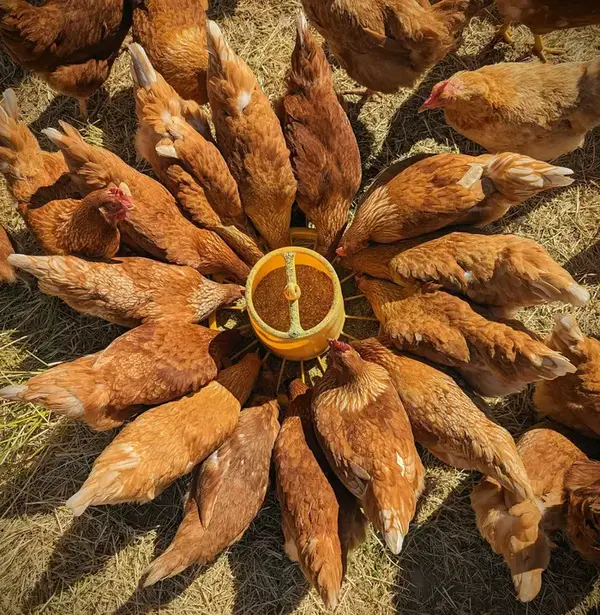
Chicken Feeder Trough
This is the most basic type of chicken feeder. The main benefit is that it’s possible to feed several chickens at once with this type. This reduces competition and ensures that everybody gets enough feed! Another advantage is that because it’s so basic, there’s very little that can go wrong. However, there are a couple of potential issues. First, it’s very accessible for vermin. Another potential problem is that chicken feeder troughs require more cleaning. Most hobbyists prefer automatic or hanging systems. If you decide to get one anway, purchase one with a raster.
Wall-Mounted Feeder
Wall-mounted chicken feeders, like the Omlet Eglu chicken feeder in the picture, are another popular option for hobbyists. These are great if you have a raster to hang them on. They’re more hygienic than a basic trough because they’re off the ground, preventing contamination with droppings, and keep the feed dry. There are also several varieties available. Be careful not to hang it too high because they won’t be able to reach their feed. The best chicken feeder position is at the bird’s back level.
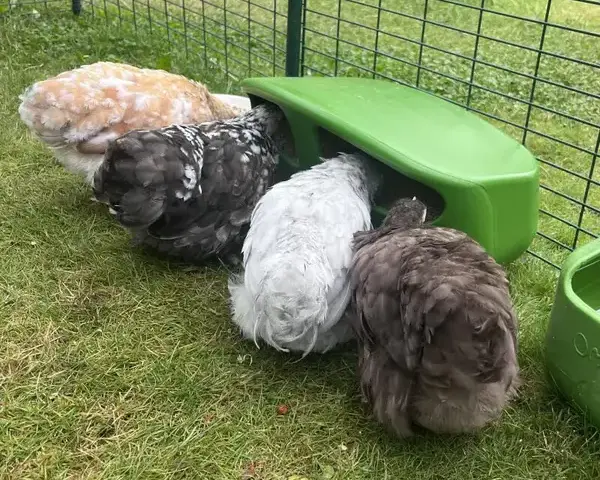
Chick Feeders
Maybe you’re planning on hatching a brood of chicks. If so, you’ll need to get a special chick feeder for these tiny birds. Baby chicks are much shorter than fully-grown hens so they need lower feeders. Again, there are many versions available but I recommend getting an easy-to-clean plastic one. The chicks will grow quickly so it doesn’t make sense to spend a fortune on all the bells and whistles!
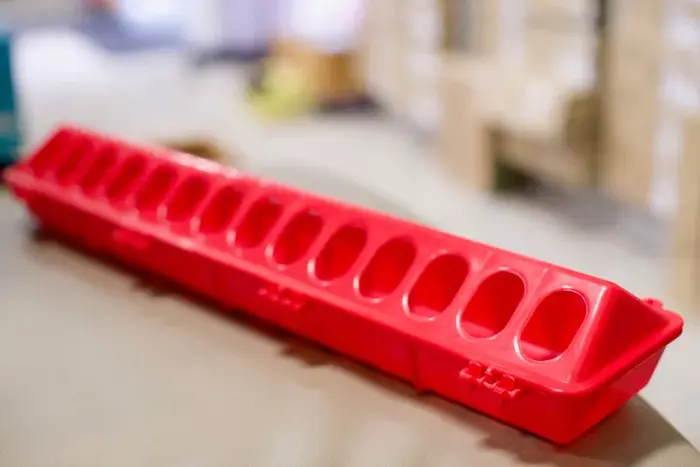
FAQS
Let’s look at some more useful information about the best chicken feeders.
What Are The Best Chicken Feeder Materials?
Chicken feeders are usually available in two materials: metal or plastic.
Galvanized chicken feeders are more expensive because of their durability. It’s easier to clean them and they are more sanitary than other types. While metal chicken feeders may rust over time, galvanized chicken feeders are metal feeders coated with a protective layer of zinc to prevent rusting.
Plastic chicken feeders are another good option because they’re cheaper than other styles. I advise buying from a reputable merchant that uses chemical-resistant plastics for your health as well as the birds. However, plastic feeders are prone to algae blooms.
Neither is perfect so it’s down to personal preference and necessity. Wood can be another option but most hobbyists don’t bother with it now. Yes, the aesthetic is nice but the feeder will rot quickly.
What Is The Best Chicken Feeder Size?
Like mentioned before in this article, choose the appropriate feeder for the number of chickens you own. A laying hen normally eats about 4 to 5 ounces (114 to 142 grams) of feed per day. Assuming you want to hold feed for about 3 days, for 4 birds you need 60 ounces, which is equal to 3,75 pounds (1,7 kg). Use this method to calculate the size of your chicken feeder.
In short, for 4 to 6 chickens, you will only need a single 5 pound (2,3 kg) feeder. A 10 pound (4,6 kg) feeder can hold enough feed for about 11 chickens. For larger flocks, I prefer multiple smaller feeders rather than one large chicken feeder, to prevent crowding.
How To Clean Chicken Feeders?
Regular cleaning is essential to keep your chickens healthy. Otherwise, you risk spreading harmful bacteria throughout your coop. Another potential issue is that your flock will stop eating or drinking because of stale chicken water and feed. Weekly cleaning is ideal but you should do it at least once every two weeks.
You will need to disassemble your feeder to clean it properly. Scrub all parts with soapy water. Don’t forget to rinse it after so no soap traces remain. You could also use a gentle antibacterial agent if necessary but be careful to choose a safe one for your chickens. Finally, allow the feeder and water station to dry completely before refilling and placing it in the coop.
Should I Leave My Feeder Inside Or Outside?
Most chicken owners leave their feeders outside because it’s more hygienic. However, you need to be aware of the weather conditions because rain will turn feed to mush. Another issue is that putting the feeder inside could attract rodents into the chicken coop. Birds and vermin may target external feeders too. But there’s a lower risk of them spreading diseases in an open area. The best chicken feeder is one that your flock can safely enjoy!
Final Thoughts
Choosing the best chicken feeder for your flock depends on your setup, budget, and the needs of your chickens. Think about factors like durability, ease of cleaning, and how well the feeder protects the feed from rain and unwanted visitors. Investing in a quality feeder not only saves you time and money in the long run but also ensures your chickens always have access to fresh, clean feed.
With many options like an automatic feeder, simple plastic hanging chicken feeder, or a galvanized chicken feeder, there is a perfect feeder for every chicken keeper. I personally prefer treadle chicken feeders, to keep rodents away. Whatever you do, opt for a no-spill design to reduce waste. The right feeder can make a big difference in keeping your chickens well-fed and your coop tidy.
No matter which feeder you choose, the most important thing is to keep an eye on your flock and adjust as needed. Happy chickens mean fresh eggs and a thriving backyard coop!
